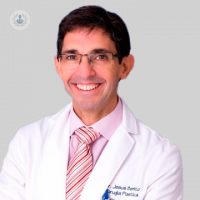Surgery for gynecomastia
Written by:What is gynecomastia and what types are there?
Gynecomastia is the alteration of the male gland or abnormal development of the male gland. All men during adolescence suffer an increase of this gland, of more or less 70-80%, what happens is that in 30% of people it remains and it is not reabsorbed. This means that these patients will suffer what is called gynecomastia and the only existing treatment is surgical. There are two types of gynecomastia, which is related to the growth of the gland and is called true gynecomastia and another type that has mostly a fat component, that is, there is an increase in adipose tissue in the area and is usually associated to patients with obesity or overweight and this is called false gynecomastia or pseudo-gynecomastia.
Are there factors that cause gynecomastia?
The most common cause of gynecomastia is the pubertal cause that is caused by hormonal disorders during adolescence and then remains. But then there are other causes such as aging or patients who go to the gym and take anabolic steroids to increase muscle mass, and also make the male mammary gland grow. It can also be caused by other medications such as gastric protectors or propecia, a medication used for hair loss..
What kind of patients are ideal for this type of surgery?
Any patient who has gynecomastia is susceptible to surgical treatment , in addition there is no other type of treatment that eliminates gynecomastia. Some hormone treatments may be useful at first, but as a general rule you have to go to surgery. Obviously, patients who have a lot of weight, obese, are recommended first to lose weight to see the actual volume of gynecomastia there is and that it is not due to excess fat.
What type of anesthesia will be used?
As a general rule, we use general anesthesia , however, in patients who have very little gland or who have what is called a protruding nipple or who have already been operated and only require a touch-up, we can use local anesthesia. But most patients prefer to sleep completely to be able to treat the area well and do a liposuction etc ...
What results can be expected after the surgery?
Normally, surgical treatment completely solves gynecomastia. In a month or so we can see the results. A patient who has a developed breast a month may appreciate that he has a flat chest and that esthetically is fine. However, the area will not be fine until months go by. The cicatrization of gynecomastia surgical treatment takes time to normalize, between half a year and a year. Unless there is a very large excess of skin, as a rule, the treatments are final in a single session. If there is excess skin can be assessed in a second part if we need to do something else.

Can moms develop again?
As a rule, the breasts do not develop again , although to improve the aesthetic result we always leave a small pill of a couple of millimeters of gland under the areola to prevent the areola from sinking, attaching to the breastplate and looking bad. Yes, we have to take into account that, depending on the circumstances, we might have a little growth of that glandular pill, for example, if a patient goes back to taking anabolic steroids or is taking a medication that could lead to gynecomastia, it could again have a small pill in the areola but never as big as he had.
How much time is necessary to resume daily activities?
Normal activities after treatment will depend a bit on the treatment we have done. In any case, as a rule, a patient operated on gynecomastia at three or four days can return to work , can drive, what you have to avoid are physical exercises of the chest area for at least a couple of weeks. From the second week you can start doing something, less muscular so we would have to wait at least a month. The recovery is quite fast considering that it will have its purples, its inflammation during a couple of weeks or three, but to resume with the completely normal activity it is necessary to calculate a month.


